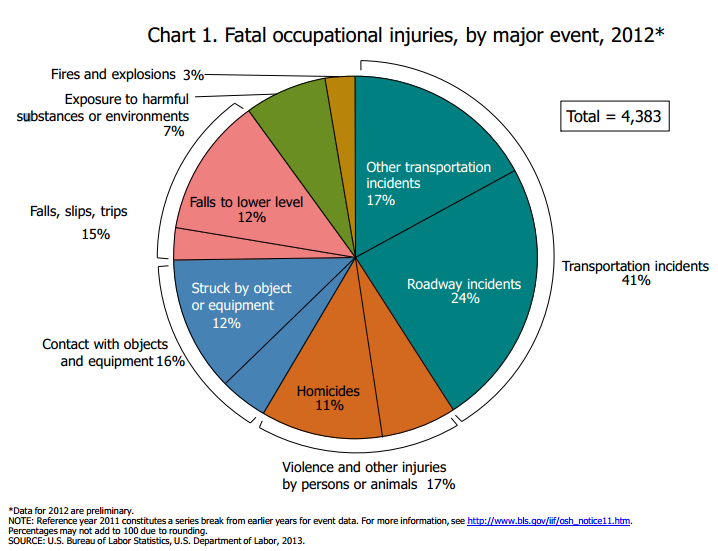Almost 4,400 Workers Died From Job-Related Injuries in 2012
by Nick Schwellenbach, 8/22/2013

An estimated 4,383 employees died from injuries sustained while working, according to new preliminary data released by the Bureau of Labor Statistics today. This is a reduction from last year’s tally of 4,693. It is also a decrease in in the fatal work injury rate from 3.5 per 100,000 full time workers in 2011 to 3.2 per 100,000 in 2012. The numbers are often revised upwards, and revisions will be released in spring 2014.

Some of the notable preliminary findings:
- “Fatal work injuries in the private mining sector rose in 2012, led by an increase in fatal injuries to workers in oil and gas extraction industries. Fatal work injuries in oil and gas extraction industries rose 23 percent to 138 in 2012, reaching a new high for the series.”
- “Fatal work injuries in the private construction sector increased 5 percent to 775 in 2012 from 738 in 2011. Total hours worked in the private construction industry increased one percent in 2012. The increase in fatal occupational injuries in 2012 follows five consecutive years of declining fatal injury counts in the construction sector. Fatal construction injuries are down 37 percent since 2006.”
- “Transportation incidents accounted for more than 2 out of every 5 fatal work injuries in 2012. (See chart 1.) Of the 1,789 transportation-related fatal injuries, about 58 percent (1,044 cases) were roadway incidents involving motorized land vehicles. Nonroadway incidents, such as a tractor overturn in a farm field, accounted for another 13 percent of the transportation-related fatal injuries. About 16 percent of fatal transportation incident in 2012 involved pedestrians who were struck by vehicles. Of the 283 fatal work injuries involving pedestrians struck by vehicles, 65 occurred in work zones.”
Although there has been a decline in fatal work-related injuries, occupational hazards are still a serious risk. Illnesses – not injuries – caused by workplace hazards, such as toxic exposures, are far more dangerous in the long run to far more workers. Some 50,000 workers die each year from occupational illnesses compared to the average of 4,500-5,000 that die annually due to workplace injuries.

Acknowledging this, the Occupational Safety and Health Administration (OSHA) has, according to its latest budget justification to Congress, begun shifting more to health inspections rather than safety inspections.
However, sequestration and any other deeper budget cuts put OSHA’s effectiveness and worker health and safety at risk. The Center for Effective Government will soon be releasing an analysis of how OSHA and other workplace safety and health agencies' budgetary resources have changed over time and how they may be affected by further cuts.




